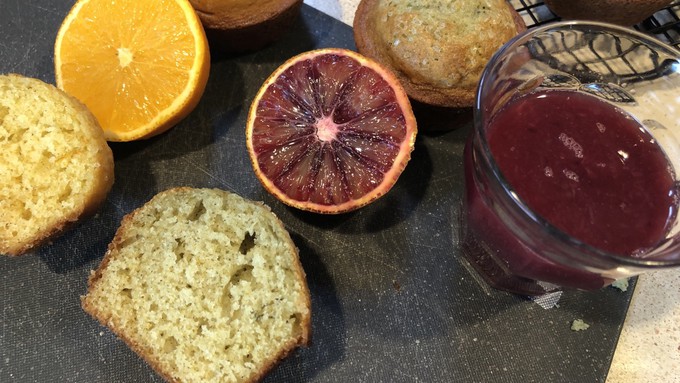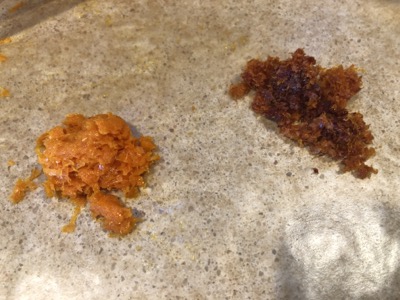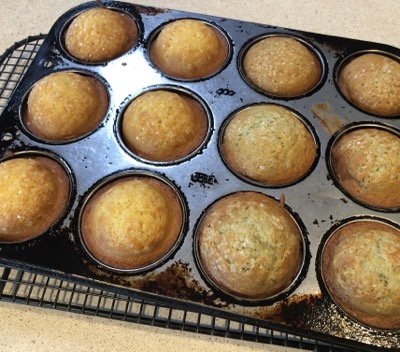
Recipe: Baking and experimenting with fresh citrus fruit

The color difference in the muffins is subtle but apparent. The red pigments in the blood orange juice turn color when combined in a mixture containing baking soda. Kathy Morrison
So much citrus, so little time while it’s fresh and in season. My Washington navel is loaded, but the produce bins are, too – with Cara Cara oranges and clementines and blood oranges. I try all of them each year, but occasionally the home supply gets to be an overload. Time to get out the juicer or bake something delicious.

I did both this week, choosing an orange cardamom muffin recipe to try. But I also wondered what they would be like if I used blood orange zest and juice. Well, the muffin recipe looked easy to divide, so I tried a side-by-side test: Half the batch got navel orange juice and zest, and the other got the gorgeous red juice and darker zest.
Scientists learn something even from a failed experiment, and I was no different. The upshot: The brilliant raspberry-red of the blood orange juice disappeared completely in baking, and the resulting muffin was an odd color, a blue tone that reminded me of a muffin I had made with fresh blueberries. Turns out the juice’s red-causing anthocyanin pigments (which also occur in raspberries) react with the baking soda and change color.
The navel orange muffins, meanwhile, stayed a beautiful orange. So if you want to show off your citrus, bake the navel orange muffins, and serve a glass of blood orange juice alongside. The recipe below is a full batch of the navel orange version.
A note on the spice: The cardamom almost disappears into this muffin, giving it additional flavor without overtaking the citrus. Cinnamon also could be used, but I might try some ground cloves next time for half the spice.
Orange spiced muffins
Makes 12
Ingredients:
3/4 cup granulated sugar
2 eggs
½ cup vegetable oil
½ cup milk (plain yogurt also would work)

Grated zest of 1 orange (½ tablespoon or more)
¼ cup freshly squeezed orange juice
2 cups all-purpose flour
2 teaspoons baking powder
½ teaspoon baking soda
½ teaspoon salt
1 teaspoon ground cardamom or cinnamon
Crunchy or sparkling sugar, for topping, optional
Instructions:

Heat oven to 350 degrees. Prepare a 12-cup muffin pan by spraying with oil or lining with cupcake papers.
In a medium bowl, whisk together the sugar, eggs, oil, milk, zest and orange juice.
In another bowl, stir together the flour, baking powder, baking soda, salt and cardamom. Stir in the wet mixture just until the flour is incorporated.
Fill the muffin cups evenly. Top each with crunchy sugar, if desired.
Bake 20 to 22 minutes, until golden brown. Allow muffins to cool for 5 minutes before removing from pan. Best served warm.
Comments
0 comments have been posted.Sacramento Digs Gardening to your inbox.
Sites We Like
Garden Checklist for week of April 14
It's still not warm enough to transplant tomatoes directly in the ground, but we’re getting there.
* April is the last chance to plant citrus trees such as dwarf orange, lemon and kumquat. These trees also look good in landscaping and provide fresh fruit in winter.
* Smell orange blossoms? Feed citrus trees with a low dose of balanced fertilizer (such as 10-10-10) during bloom to help set fruit. Keep an eye out for ants.
* Apply slow-release fertilizer to the lawn.
* Thoroughly clean debris from the bottom of outdoor ponds or fountains.
* Spring brings a flush of rapid growth, and that means your garden needs nutrients. Fertilize shrubs and trees with a slow-release fertilizer. Or mulch with a 1-inch layer of compost.
* Azaleas and camellias looking a little yellow? If leaves are turning yellow between the veins, give them a boost with chelated iron.
* Trim dead flowers but not leaves from spring-flowering bulbs such as daffodils and tulips. Those leaves gather energy to create next year's flowers. Also, give the bulbs a fertilizer boost after bloom.
* Pinch chrysanthemums back to 12 inches for fall flowers. Cut old stems to the ground.
* Mulch around plants to conserve moisture and control weeds.
* From seed, plant beans, beets, cantaloupes, carrots, corn, cucumbers, melons, radishes and squash.
* Plant onion sets.
* In the flower garden, plant seeds for asters, cosmos, celosia, marigolds, salvia, sunflowers and zinnias.
* Transplant petunias, zinnias, geraniums and other summer bloomers.
* Plant perennials and dahlia tubers for summer bloom.
* Mid to late April is about the last chance to plant summer bulbs, such as gladiolus and tuberous begonias.
* Transplant lettuce seedlings. Choose varieties that mature quickly such as loose leaf.